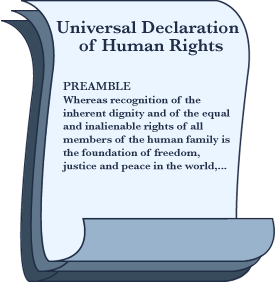|
|
|||||
|
|||||
| Source: United Nations. (full source) |
Full Source: The text of the Declaration is available online from the UN at
http://www.un.org/Overview/rights.html. Additional resources regarding
human rights can be found at http://www.un.org/rights. Both were
accessed March 31, 2005. For the texts of other documents mentioned see
the following (all accessed March 31, 2005):
Declaration of Independence http://www.archives.gov/national_archives_experience/charters/ declaration.html
Declaration of the Rights of Man and the Citizen http://www.constitution.org/fr/fr_drm.htm
Perpetual Peace http://www.mtholyoke.edu/acad/intrel/kant/kant1.htm
Rerum Novarum http://www.vatican.va/holy_father/leo_xiii/encyclicals/documents/hf_l- xiii_enc_15051891_rerum-novarum_en.html
Pacem in Terris http://www.vatican.va/holy_father/john_xxiii/encyclicals/documents/hf_j- xxiii_enc_11041963_pacem_en.html
Declaration of Independence http://www.archives.gov/national_archives_experience/charters/ declaration.html
Declaration of the Rights of Man and the Citizen http://www.constitution.org/fr/fr_drm.htm
Perpetual Peace http://www.mtholyoke.edu/acad/intrel/kant/kant1.htm
Rerum Novarum http://www.vatican.va/holy_father/leo_xiii/encyclicals/documents/hf_l- xiii_enc_15051891_rerum-novarum_en.html
Pacem in Terris http://www.vatican.va/holy_father/john_xxiii/encyclicals/documents/hf_j- xxiii_enc_11041963_pacem_en.html

